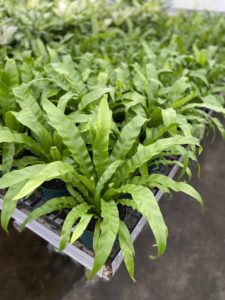
The Bird’s Nest fern is native to the rain forests of Asia, Africa, and Australia which explains why high humidity is essential for it to thrive. This fern has long, erect, leathery, apple-green fronds that never split like those of a Kimberly Queen fern or a Maidenhair fern.
When the new fronds first emerge they resemble little bird eggs which is why we call it a Bird’s Nest fern. It’s important to never get water on the crown or it will develop plant diseases.
A Bird’s Nest fern does well in medium indirect light. The distinctive bright green leaves become pale when exposed to too much light. Direct sun causes unsightly burn marks on the leaves.
Keep the soil moist but never soggy at all times.
A Bird’s Nest fern likes temperatures between 70°-90°F (21.1°-32.2°C) during the day and about 10° cooler at night. These ferns grow slowly when the temperature is not within this range and leaves are damaged by hot or cold drafts. The base of the fronds turn yellow when the temperature is too warm.
High humidity is essential. The higher the humidity the longer the fronds grow, indoors this can be up to 18” and outdoors 3ft-4 ft. Lack of humidity causes major problems: the entire leaf may turn yellow, the tips of the leaves may turn brown, and the plant may stop growing. If the humidity in your home is too low, consider putting your fern on a wet pebble tray, be sure the plant is sitting on pebbles and not in the water.
A Bird’s Nest fern is susceptible to Mealy Bugs, scale, and Aphids. Use a Qtip dipped in alcohol to treat Plant Pests near or on the crown; never spray any liquid directly on the crown.
Misting encourages bacterial and fungal infections such as Erwinia Blight. The leaves should always be kept dry.
Bird’s Nest ferns grow well in a soil high in organic material that holds water but is still loose and not heavy and clay-like.
